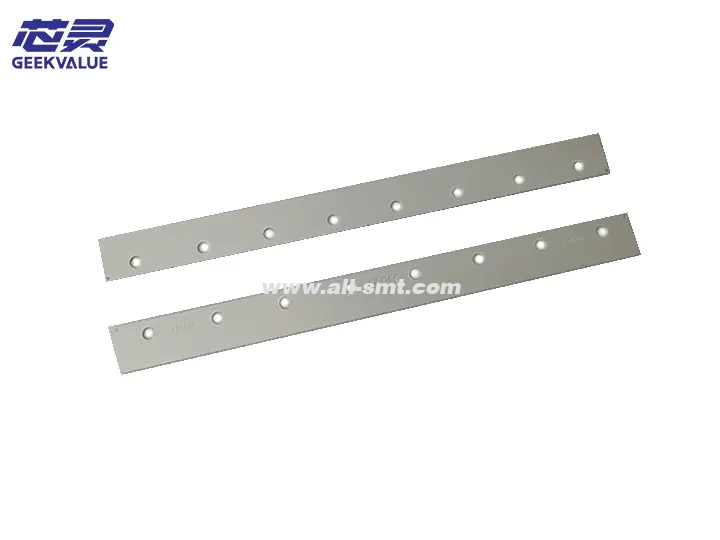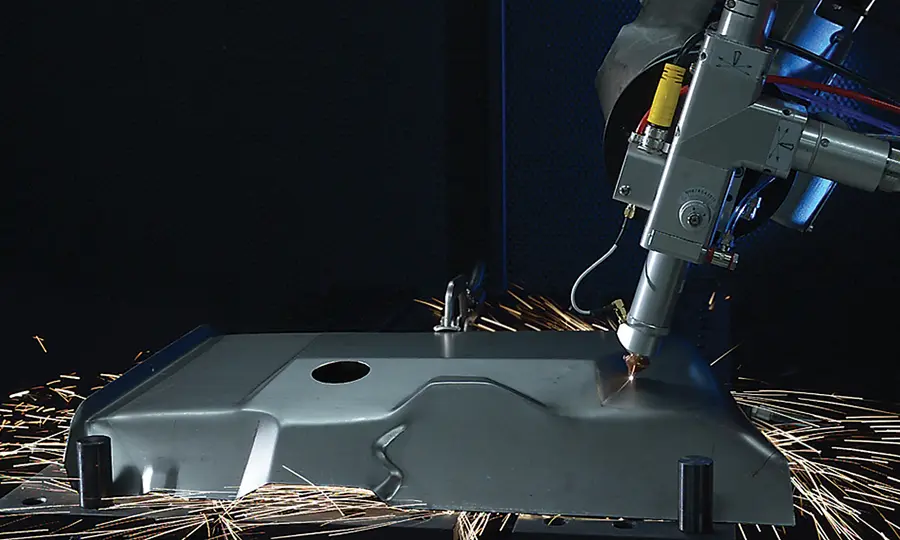1. Product Overview and Core Function
1.1 Core Function of Scraper Blade
DEK printer scraper blade is the core executive component in solder paste printing process, directly affecting:
Uniformity of solder paste deposition
Precision of printed graphics
Consistency of pad coverage
Process stability
1.2 Typical application scenarios
High-density interconnect (HDI) board printing
Fine-pitch components (below 0.3mm pitch)
Mixed packaging process (solder paste + red glue)
High-precision packaging (CSP/BGA)
2. Working principle and physical properties
2.1 Working principle
Shearing action:
The scraper contacts the steel mesh at an angle of 45-60°
Produces a high shear rate of 2000-5000s⁻¹
Makes the solder paste flow thixotropicallyFilling stage:
The scraper pushes the solder paste to fill the mesh
The optimal filling pressure range is 30-100N
Release stage:
Micron-sized solder paste columns are formed when the steel mesh is separated
The release angle affects the demolding quality
2.2 Key physical parameters
Parameter Standard value Allowable deviation
Hardness (Shore A) 75-90 ±5
Elastic modulus 3-8MPa ±10%
Surface roughness (Ra) ≤0.2μm +0.05μm
Temperature range -20℃~120℃ Short-term tolerance +20℃
Wear resistance coefficient ≤0.15 (ASTM D1044) +0.03
III. Product classification and technical features
3.1 Material type comparison
Type Polyurethane (PU) Metal scraper Composite material
Hardness 75-90A HRC60-65 85A (surface)
Life 500,000-1 million times 5 million times + 2 million-3 million times
Applicable solder paste Conventional SnPb/lead-free High viscosity solder paste Nano silver paste
Cost Low High Medium
Features Easy to replace, strong versatility Ultra-high precision Anti-static design
3.2 DEK-specific design features
Blade geometry optimization:
Double bevel design (front angle 25° + back angle 15°)
Blade straightness ≤0.01mm/300mm
Dynamic compensation structure:
Pressure adaptive adjustment
Temperature deformation compensation
Special interface:
Quick-release mounting slot
Fool-proof positioning design
IV. Process influence and core functions
4.1 Impact on printing quality
Thickness control:
Blade wear 0.1mm → Solder paste thickness change ±5μm
Optimal wear limit: ≤0.3mm
Graphic quality:
Blade defects cause:
Pull tip (>30° scraper angle)
Depression (insufficient pressure)
Tail (return speed is too fast)
Process window:
python
# Typical process parameter range
{
"pressure": 50-80N, # Printing pressure
"speed": 20-80mm/s", # Scraper speed
"angle": 45-60°, # Contact angle
"overlap": 0.5-2mm # Steel mesh coverage
}
4.2 Core function realization
Precision measurement:
Control solder paste transfer amount (60-90% mesh volume)
Thickness deviation ≤±5μm (CPK≥1.67)
Surface leveling:
Eliminate residual solder paste on steel mesh
Surface flatness ≤2μm
Shear activation:
Reduce solder paste viscosity (thixotropy ≥85%)
V. Advantage analysis and technological innovation
5.1 Competitive advantage
Precision advantage
Achieve ±15μm printing repeatability
Support 01005 component printing
Life advantage:
Polyurethane scraper life extended by 50% (compared to industry standards)
Metal scraper can be flipped for use
Compatibility advantage:
Adapt to all DEK printing models
Support nano coating treatment
5.2 Technological innovation
Gradient hardness technology:
Edge hardness 90A → Body hardness 75A
Reduce stress concentration
Microtexture technology:
Laser processing micron-level grooves
Reduce friction coefficient by 30%
Intelligent wear monitoring:
Embedded RFID chip
Record the number of times used in real time
VI. Maintenance and troubleshooting
6.1 Daily maintenance specifications
Item Method Cycle
Cleaning the cutting edge Dust-free cloth + IPA (99.7%) Every shift
Check wear Optical comparator measurement Weekly
Hardness test Shore A hardness tester (three-point measurement method) Monthly
Stress release Hang and stand for 24 hours Quarterly
6.2 Common fault handling
Fault phenomenon Cause analysis Solution
Uneven solder paste thickness Cutting edge wear/deformation Replace scraper
Printing tip Too large angle/cutting edge burr Adjust angle to 50°
Misprinting Insufficient pressure/low hardness Increase pressure by 10-15N
Scraper jump Loose installation/bearing wear Tighten and lubricate the guide rail
6.3 Life management strategy
Wear monitoring standards:
Polyurethane: Replace when edge wear > 0.3mm
Metal: Replace when edge damage is visible
Refurbishment and reuse:
Metal scrapers can be ground and repaired (≤ 3 times)
Polyurethane scraper edge trimming (special equipment)
VII. Process optimization suggestions
7.1 Parameter matching principle
Speed-pressure relationship:
text
Low speed (20-40mm/s): high pressure (70-100N)
High speed (60-80mm/s): low pressure (40-60N)
Angle selection guide:
Fine pitch: 60° (reduce tailing)
Large pad: 45° (enhanced filling)
7.2 Special process application
Step steel screen printing:
Use double hardness scraper
Front section 75A/rear section 85A
Ultra-fine pitch printing:
Use diamond coated scraper
Surface roughness ≤0.05μm
High viscosity solder paste:
Recommend metal scraper
Pressure increased by 20-30%
VIII. Technology development trend
8.1 Material innovation
Graphene enhanced polyurethane (wear resistance +200%)
Self-healing elastomer material
8.2 Intelligent upgrade
Integrated pressure sensor (real-time feedback)
Temperature-pressure coordinated control
8.3 Green manufacturing
Biodegradable scraper material
Dry cleaning technology (reduce IPA use)
IX. Selection and use recommendations
9.1 Selection matrix
Application scenario Recommended type Life expectancy
Mass production Metal scraper 6-12 months
High mix production Polyurethane scraper 1-3 months
Special alloy solder paste Ceramic coated scraper 3-6 months
R&D trial production Composite scraper, flexible replacement
9.2 Precautions for use
Installation specification:
Use torque wrench (5-8N·m)
Confirm parallelism (≤0.02mm)
Storage conditions:
Store away from light (UV protection)
Place horizontally (anti-deformation)
Scrap standard:
Polyurethane: hardness change ±10%
Metal: edge chipping>0.1mm
Ten. Summary
As a key consumable for precision printing, the technological development of DEK printing machine scraper blade presents:
High precision: support components below 01005
Long life: metal scraper life exceeds 10 million times
Intelligent: integrated sensing and feedback functions
Best practice recommendations:
Establish scraper life cycle archive
Implement preventive replacement system
Carry out process parameter DOE optimization
In the future, with the development of 5G/6G, advanced packaging and other technologies, scraper technology will continue to evolve towards ultra-precision, multi-function and sustainable directions.








